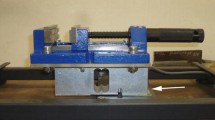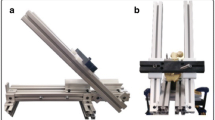Abstract
Introduction
The occurrence of vascular injury during drilling is a rare but severe complication. Unfortunately, drilling protection systems are not available in all hospitals. Thanks to the development of 3D printing in recent years, sharing devices and materials to solve surgical problems has become easy and inexpensive. The objective of our work is to evaluate a universal, freely accessible, 3D-printable drilling protection device.
Materials and methods
A prospective, randomized, and triple-blind evaluation of excess drilling was evaluated in expert surgeons and resident surgeons without the use of the protection device. Subsequently, excess drilling was assessed using the device in both groups. The differences in drilling lengths between both groups with and without the device were analyzed to establish the reduction of excess drilling in both groups.
Results
The drilling in the expert surgeon without device group was 3.03 mm (SD 1.69 95% CI 2.40–3.66 p value = 9.89e−11), while the resident surgeon with device group performed excess drilling of 1.76 mm (SD 0.89 CI 95% 1.43–2.10). Results showed better results in the resident surgeon with device group than in the expert surgeons with device group (p value ˂ 0.01). The device improved drilling in both resident surgeons (5.77 mm) and expert surgeons (1.17 mm).
Conclusions
The device improves drilling in both expert surgeons and resident surgeons, showing greater benefits in the latter. The device is printable with any 3D printer, making it universally accessible, inexpensive, and effective, allowing expert surgeons to improve precision in high-risk situations and resident surgeons to improve their technique without increasing risk to the patient.





Similar content being viewed by others
References
Sözen T, Özışık L, Başaran NÇ. An overview and management of osteoporosis. Eur J Rheumatol. 2017;4(1):46–56.
Kani KK, Porrino JA, Mulcahy H, Chew FS. Fragility fractures of the proximal femur: review and update for radiologists. Skeletal Radiol. 2019;48(1):29–45.
Bhandari M, Swiontkowski M. Management of acute hip fracture. N Engl J Med. 2017;377(21):2053–62.
Court-Brown CM, Duckworth AD, Clement ND, McQueen MM. Fractures in older adults. A view of the future? Injury. 2018;49(12):2161–6.
Rosengren BE, Karlsson MK. The annual number of hip fractures in Sweden will double from year 2002 to 2050: projections based on local and nationwide data. Acta Orthop. 2014;85(3):234–7.
LeBlanc KE, Muncie HLJ, LeBlanc LL. Hip fracture: diagnosis, treatment, and secondary prevention. Am Fam Physician. 2014;89(12):945–51.
Potera C. Seniors need hip fracture surgery within 24 hours. Am J Nurs. 2018;118(3):14.
Haviari S. Wait time for hip fracture surgery and mortality. JAMA. 2018;319(21):2234.
Roberts KC, Brox WT, Jevsevar DS, Sevarino K. Management of hip fractures in the elderly. J Am Acad Orthop Surg. 2015;23(2):131–7.
Chlebeck JD, Birch CE, Blankstein M, Kristiansen T, Bartlett CS, Schottel PC. Nonoperative geriatric hip fracture treatment is associated with increased mortality: a matched cohort Study. J Orthop Trauma. 2019;33(7):346–50.
Carulli C, Piacentini F, Paoli T, Civinini R, Innocenti M. A comparison of two fixation methods for femoral trochanteric fractures: a new generation intramedullary system vs sliding hip screw. Clin Cases Miner Bone Metab Off J Ital Soc Osteoporos Miner Metab Skelet Dis. 2017;14(1):40–7.
Stockton DJ, Dua K, O’Brien PJ, Pollak AN, Hoshino CM, Slobogean GP. Failure patterns of femoral neck fracture fixation in young patients. Orthopedics. 2019;42(4):e376–e380380.
Chughtai M, Khlopas A, Mont MA. Fracture fixation in the operative management of hip fractures (FAITH): an international, multicentre, randomised controlled trial. Lancet Lond Engl. 2017;389(10078):1519–27.
Zhang B-F, Cong Y-X, Wang P-F, Huang H, Wang H, Zhuang Y. Deep femoral artery branch pseudoaneurysm formation and injury after hip fracture surgery: a case series and a literature review. Medicine (Baltimore). 2018;97(6):e9872.
Barquet A, Gelink A, Giannoudis PV. Proximal femoral fractures and vascular injuries in adults: incidence, aetiology and outcomes. Injury. 2015;46(12):2297–313.
Neubauer T, Grechenig S, Leitner L, Auffarth A, Plecko M. Vascular complications in plating of the proximal femur: review. Arch Orthop Trauma Surg. 2016;136(4):539–51.
Tomčovčík L, Kováč P, Daňo J, Čuha R. Late laceration of the superficial femoral artery by an intertrochanteric fracture fragment. Hip Int J Clin Exp Res Hip Pathol Ther. 2011;21(2):273–5.
Clement H, Heidari N, Grechenig W, Weinberg AM, Pichler W. Drilling, not a benign procedure: laboratory simulation of true drilling depth. Injury. 2012;43(6):950–2.
McIntosh AL. Surgical treatment of adolescent clavicle fractures: results and complications. J Pediatr Orthop. 2016;36(Suppl 1):S41–43.
Bernhoff K, Björck M. Iatrogenic popliteal artery injury in non arthroplasty knee surgery. Bone Jt J. 2015;97-B(2):192–6.
Wang X-Z, Shi Z, Lu Q-L, Xie W, Chen L, Li X-G, et al. Treatment of old acetabular posterior wall fracture with 3D printing combined with composite plate internal fixation. Zhongguo Gu Shang China J Orthop Traumatol. 2019;32(5):395–400.
You W, Liu LJ, Chen HX, Xiong JY, Wang DM, Huang JH, et al. Application of 3D printing technology on the treatment of complex proximal humeral fractures (Neer3-part and 4-part) in old people. Orthop Traumatol Surg Res OTSR. 2016;102(7):897–903.
Tomaževič M, Kristan A, Kamath AF, Cimerman M. 3D printing of implants for patient-specific acetabular fracture fixation: an experimental study. Eur J Trauma Emerg Surg Off Publ Eur Trauma Soc. 2019
Funding
The author(s) received no financial support for the research, authorship, and/or publication of this article.
Author information
Authors and Affiliations
Corresponding author
Ethics declarations
Conflict of interest
The author(s) declared no potential conflicts of interest with respect to the research, authorship, and/or publication of this article.
Patient consent and ethical approval
The patient provided written informed consent for the publication of medical information and images.
Rights and permissions
About this article
Cite this article
Ferràs-Tarragó, J., Jordà-Gómez, P., Català-de-las-Marinas, J. et al. A new universal 3D-printable device to prevent excessive drilling in orthopedic surgery. Eur J Trauma Emerg Surg 48, 3887–3893 (2022). https://doi.org/10.1007/s00068-020-01465-3
Received:
Accepted:
Published:
Issue Date:
DOI: https://doi.org/10.1007/s00068-020-01465-3




